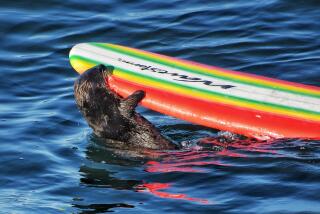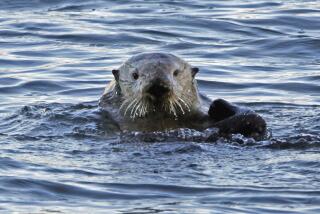Sea World Scientists to Put Disaster Study on Sea Otters to Use
- Share via
Five years ago, a team of scientists at Sea World’s Hubbs Marine Research Institute began studying ways to clean sea otters in the event of an oil spill. Using pelts confiscated from poachers, the researchers experimented with a wide range of techniques in search of a state-of-the art method of degreasing the furry animals.
Last summer, they unveiled their breakthrough recipe for success: Apply a mixture of Dawn liquid detergent and water, and scrub.
It may sound mundane, but the research, published in a thick manual entitled “Sea Otter Oil Spill Contingency Plan,” has landed two of the scientists a vital role in the rescue effort launched in the wake of last Friday’s oil spill in pristine Prince William Sound.
The $125-million tanker Exxon Valdez dumped nearly 11 million gallons of crude oil into the Alaskan sound after it ran aground on a rock pinnacle. Exxon executives have conceded it is now too late to trap the spill, which covers more than 500 square miles, before it has a major impact on nearby shorelines.
Dispatched to Alaska
On Sunday, Sea World physiologists Randall Davis and Terrie Williams were dispatched to Valdez to help environmentalists and wildlife authorities determine the effect of the spill and to minimize any effect on the sound’s otter population of about 5,000.
The scientists have set up a recovery center in an empty school and have secured the use of two boats and a helicopter to help capture any oil-soaked otters.
Exxon called Davis and said, “would you please come up here and help us be prepared in case oil gets into the areas where the sea otters are?” said Jon Hall, another institute scientist involved in the otter research. “They said, ‘We’ll cover any air fare. Just please get here.’ ”
Hall and a fourth scientist from Sea World, Ann Bowles, are on stand-by and may be called to assist Davis and Williams, institute officials said.
John Nelson, deputy assistant regional director of the U. S. Fish and Wildlife Service in Anchorage, said his staff spotted 200 otters Wednesday near two islands whose shores were either flooded with oil or would be soon. Of the 200 otters, about 20 were found to be swimming in oily water.
Nelson said that, so far, only two otters have been found to be visibly sick from the contamination. But, if there are more, Davis and Williams will be ready to show others how to handle the creatures. That, apparently, is no easy task.
Dangerous Despite Looks
“They look like wonderful, cuddly organisms but they are very large wild animals and they can be--when they’re cornered--extremely ferocious, regardless of your best intentions,” said Hall. “They don’t like (being handled) at all. If one’s going to come away with fingers and hands, one has to be very careful of how you handle sea otters.”
In their quest for the perfect deoiling method, the scientists tried a wide variety of
special commercial cleansers and experimental anti-grease compounds. They even played back recordings of killer whales to see if they could scare the otters from a spill site.
Also developed were techniques to capture, anesthetize and monitor the animals for days after they were deoiled.
Hall said the cleansing method the researchers finally settled on involves the use of a detergent--specifically, Dawn, which boasts that it is tough against grease.
“The procedure requires lots of warm water, and it requires lots of expertise in handling the otters,” Hall said.
Unlike marine animals that have a layer of blubber to protect them from the cold, sea otters have only their coat of fur to rely on for insulation and must constantly groom themselves to maintain air trapped in between the hairs.
“They almost pop out of the water because they’re so buoyant,” Hall explained. “And, when the oil gets on their fur, it penetrates the fur, it mats the fur together and the fur can no longer hold air, so the cold of the water penetrates directly to their skin.
Research for the “Sea Otter Oil Spill Contingency Plan” was prompted by concern that increased offshore oil drilling could threaten the California sea otter, an endangered species numbering about 1,000, according to Don Kent, Hubbs’ director.
“It was believed that a single oil spill or that type of a problem . . . could wipe out the whole population or . . . deplete the population significantly,” Kent said.
More to Read
Sign up for Essential California
The most important California stories and recommendations in your inbox every morning.
You may occasionally receive promotional content from the Los Angeles Times.













